#nuenonne
Explore tagged Tumblr posts
Text
Hey don't cry, here's a story about a boy and a puppy thylacine (Kaparunina*) from the people who saw them.
youtube
How the Tasmanian Tiger got his stripes.
*Kaparunina is the name of the Tasmanian Tiger in Palawa kani, a reconstructed/composite language created by people of various indigenous tribes of Tasmania.
There is a referral to rape later on in the video, but the actual story stops before that.
#tw rape mention#thylacine#nuenonne#lunawanna-alonnah#bruny island#palawa#litruwita#tasmania#kaparunina#tasmanian tiger#aboriginal australia#dreamtime#dreamtime story#indigenous history#indigenous#puppy#indigineous people#first nations#indigenous rights#rape#tw rape#rape mention#video#animation#Youtube#you tube#youtube
15 notes
·
View notes
Text
A Dreamtime story from the Nuenonne First Nation of Bruny Island off the Southeast Coast of Tasmania (lutruwita) narrates how [...] a young pup [...] of the “Tasmanian tiger” (thylacine) [...] transformed [...] into corinna [...]. When lutruwita -- Tasmania, also known as Van Dieman’s Land -- was opened for British colonization in 1803, a medley of settlers -- from [...] fortune-seekers to species hunters -- made it to the island in the course of a few years. Travel guides and memoirs published at the time soon dubbed Tasmania the “sanatorium of India,” drawing many British colonists to the island who hoped to recuperate their health debilitated by prolonged stay in the tropics.
More significantly, it wasn’t only materials and bodies that circulated between the colonies [India and Tasmania]. But also ideas, impressions, and experiences gained in one colony made their way to the other. [...]

Settler farmers identified the thylacine as a “blood sucking vampire” [...]. [P]olitician John Lyne -- a representative of the Tasmanian rural lobby -- proclaimed, quite preposterously, that “30000 or 40000 sheep” were taken each year by the thylacine [...]. By 1830, the Van Diemen’s Land Company was already offering a reward for the killing of [...] the “hyena” i.e. the thylacine. Likewise, Mercury reported in 1882 in a piece headlined “Tiger Extermination” that landowners declared “a reward of £5 to be paid for each full-grown tiger [...] and £2 10s, for all cubs [...]." As a result, the animal [...] was extirpated by 1936. Comparison between the thylacine and the Indian tiger abounded in settler discourses [...]. This was in spite of the fact that the thylacine and the Indian tiger were two entirely different species, morphologically and ecologically. [...] Yet early settlers in Tasmania, many of whom had first landed on or had connections in British India carried the idea of the tiger as a ferocious predator [...]. [T]hese representations of the thylacine’s “nature” were based on faulty understanding of the animal perpetuated by myopic colonial science that privileged imperial economic interests above all. [...]
---
One of the major thylacine traders in Tasmania was James Harrison. Known as the “West Coast naturalist,” Harrison purchased and sold about twenty-five live animals and twenty dead specimens of thylacine. He was born in the Nowgong district of Assam in northeast India to a family of speculators en route from England. It is noteworthy that James Harrison spent his childhood in a region in India that was known for its [...] wildlife. Game hunting [...] was [...] [a] common pursuit among the Europeans in Assam [...]. Moreover, the period saw a spike in the visit of professional hunters and species collectors to the region as vast [habitat] was being stripped off to make way for tea plantations. [...]
---
William Thomas Dennison, who served as governors of Van Diemen’s Land (Tasmania) and Madras in India, described in Varieties of Vice Regal Life (1870) the tiger hunts he had organized in India. Dennison’s book reinforced the idea that the tiger is a pest, an impediment to human progress, which echoed his policies towards the thylacine during his stint as the governor of Tasmania (1847-1854). [...]
---
Likewise, Sainthill Eardley Wilmot -- the grandson of Sir John Eardley Wilmot, the lieutenant-governor of Van Diemen’s Land from 1843 to 1846 -- served as a forestry officer in British India. Sainthill was born in Hobart in 1852 and spent his early life there. In My Home In Tasmania (1852), Louisa Ann Meredith mentions the presence of an “untamed” wild thylacine in Sainthill’s grandfather Sir John Eardley Wilmot’s private menagerie in Hobart. Later Sainthill Eardley Wilmot would take a particularly hostile attitude towards the tiger and other big cat species while working as the Inspector General of Forests in British India. [...] He also wrote an it-narrative about the Indian tiger, The Life of a Tiger (1911), that predicted the tiger’s impending extinction. On multiple occasions, he has alluded to the thylacine “wreaking havoc” on flocks of sheep in Tasmania. [...]
The material circulation of the living thylacine in India is little known apart from an exhibition of two live members of the species at Madras Zoo in 1886 [...]. The narrative circulation of the animal, however, has been relatively plentiful.
---
Text by: Bikash Kumar Bhattacharya. "Constellation Spirit, Vicious Vermin, and Icon of Environmental Guilt: Affective Entanglements of the Thylacine in Tasmania and India". The Otter, Network in Canadian History and Environment (NiCHE). Emotional Ecologies series (edited Jessica M. DeWitt and Sarah E. York-Bertram). 20 July 2023. Published at: niche-canada DOT org/2023/07/20/constellation-spirit-vicious-vermin-and-icon-of-environmental-guilt-affective-entanglements-of-the-thylacine-in-tasmania-and-india/ [Image and caption are shown unaltered as they originally appear included in Bhattacharya's article. Bold emphasis and some paragraph breaks/contractions added by me. Presented here for commentary, teaching, criticism purposes.]
52 notes
·
View notes
Text

Finalist – animals in nature: Taking the easy route
A platypus decides to climb around a waterfall in a small creek, rather than swimming through it. Although easier, this does expose the platypus to potential predators, such as dogs. Platypuses are able to tuck the webbing of their front feet out of the way while on land and are surprisingly good climbers. Nuenonne Country, South Hobart, Tasmania
Photograph: Daniel van Duinkerken. Australian Geographic nature photographer of the year 2024
1 note
·
View note
Photo

36 day 1836 (anybody tree father)When Truganini met George Augustus Robinson, the Chief Protector of Aborigines, in 1829, her mother had been killed by sailors, her uncle shot by a soldier, her sister abducted by sealers, and her fiancé brutally murdered by timber-cutters, who then repeatedly sexually abused her. In 1830, Robinson moved Truganini and her husband, Woorrady, to Flinders Island with the last surviving Tasmanian Aboriginals, numbering approximately 100. The stated aim of isolation was to save them,[citation needed] but many of the group died from influenza and other diseases. In 1838 Truganini also helped Robinson to establish a settlement for mainland Aboriginals at Port Phillip.[5] After about two years of living in and around Melbourne, she joined Tunnerminnerwait and three other Tasmanian Aboriginals as outlaws, robbing and shooting at settlers around Dandenong, which triggered a long pursuit by the authorities. The outlaws moved on to Bass River and then Cape Paterson. En.wikipidia.org B(1871) p187 TASMANIA, THE LAST OF THE ABORIGINALS (LADY).jpg Truganini in 1870. Born c. 1812 Bruny Island, Van Diemen's Land Died 8 May 1876 (aged 63–64) Hobart, Tasmania, Australia Other names Truganini, Trucanini, Trucaninny, and Lallah Rookh "Trugernanner" Known for Last surviving full-blooded Aboriginal Tasmanian[citation needed] and terminal speaker of the Nuenonne language[citation needed] Spouse(s) Woorrady En.wikipidia.org the grows fonder planted from a solemn seed not infact matter of fact a noxious need human biped bipedal crazy red head water shed ✊🍔😍🎸🍰Ⓜ️☹️🤬🤖🤫🤔😷🦠✅ has the penny dropped sloops don’t dog MENULOG sprigs sorogs sprogs viewers noonday walkers heavy breathing rubbernecked gawkers quick steppers bye hecklers frenzy frenetic not never asthetic in our atmosphere viewers quick steppers noonday walkers night stalkers occasionals #russelcrowe ucken Crowe’s 🇨🇳🚯@scottmorrisonmp @danandewsmp#writing @scottmorrisonmp @danandewsmp#writing #believensucceed #creatives #gymheads #buddingchefs #influencers #social-lights @todayshow9 #karltodays09ism #regmombassa @time @thenewyorker (at Tasmania) https://www.instagram.com/p/CC7Vqcapi5l/?igshid=cf4iuqvkqebz
#russelcrowe#writing#believensucceed#creatives#gymheads#buddingchefs#influencers#social#karltodays09ism#regmombassa
0 notes
Text
Over & Under exercise
Exercise #4 (Deidre Brown)
Over -

The over storyboard shows 5 different times of the day, at Allens Rivulet, Tasmania, Australia. These watercolour images show wildlife native to the land, where Aboriginal cultures believed their ancestors such as animal and/or supernatural spirits provided these animals and the surrounding landscape. I have put emphasis on the changing colour of the sky throughout the day and focussed primarily on the animal life of Allens Rivulet, while showing some plants and other surrounding features which make this place unique.
“Dreamtime is the foundation of Aboriginal religion and culture. It dates back some 65,000 years. The aboriginal people believed that the land used to be empty of life forms. During what is now known as Dreamtime, they believed waterholes, mountains, hills, rivers, plants, animals and humans were formed by the actions of mysterious and supernatural spirits. Distinct tribes had different philosophies and beliefs about the Ancestors who made the world, where some believed that the Ancestors were animal-spirits. It is believed that the Spirits gave them their hunting tools and each tribe its land, their totems and their Dreaming. During dreamtime the creators declared the laws of the land, the customs of food supply and distribution, the rituals of initiation, the ceremonies of death so the spirit of the dead travels peacefully to his or her spirit-place, and the laws of marriage. They were told all this from their ancestors who they always trusted. Dreamtime and Aboriginal spiritual beliefs are not generally well understood by non-indigenous people.” -https://www.aboriginal-art-australia.com/aboriginal-art-library/aboriginal-dreamtime/

Under -



Aboriginal dot paintings were used to tell stories; originally colours were restricted to variations of red, yellow, black and white produced from ochre, charcoal and pipe clay. Later acrylic mediums were introduced allowing for more vivid colourful paintings.

The land in Tasmania was previously connected to mainland Australia, however when the bass straight formed (sea between mainland and Tasmania), Tasmanian Aboriginals were stranded. They began hunting and gathering and formed 8 different tribes across the island, where the south east tribe (where my property is located) was called Nuenonne (Nyunoni).

65,000 years ago, indigenous Australians lived with the land; hunting, fishing, gathering, painting, singing, dancing.... They used crushed rocks to form paint for artworks in cave painting, painting on the ground or on bark. They used bark, clay, leaves and logs in creating homes. They had a developed understanding of how to survive and live on the land; prioritising connections with family and living simply, taking only what they needed for survival.
In 1803, European settlers invaded Tasmania, taking children, murdering men and beating women. White invaders thought indigenous Australians were not looking after their children properly and they wanted to make them “civilised and christianised”, classing them as animals. Europeans won the land of Tasmania and mainland Australia due to their superior weaponry during the Black War.
Nuenonne “Nyunoni" is south west Tasmania tribe where they had their own language and culture. Truganinni was the last full blood Tasmanian Aboriginal; she was in the Nuenonne area. To this day, there are no full blood aboriginal people of Tasmania, as white settlements took their lives.
In 2007, Kevin Rudd Australian prime minister finally made an apology to indigenous Australians, on behalf of white settlers. It took up until only 13 years ago to say sorry, and still there is very minimal to no teaching/recognition in Australian society and schools of this history of the devastating black war and previous uses for the land we live on.
0 notes
Text
Tawe Nunnugah – A Rowing Voyage
This story begins in the Outer Hebrides in the seventies. In front of me is a man sawing up a TV aerial. Badly folded into his fifties, he is dressed in a tweed cap and a dungaree jacket. A tweed weaver, he has served his time in the Royal and the Merchant Navies. His task is to replace the broken wooden shaft of a “croman”, a primitive cultivation implement. Presently this man, my father, turns from his labour and hands me his completed project. The ancient rugged hand-made iron head now sits at the end of a glinting aluminium alloy silver pole.
”There you are and don’t break it.”
He omits the “again”

At this point I am a teenager helping my extended family manually dig up hunderweights of Golden Wonder, Kerr’s Pink and King Edwards. Our household has no motorcar but soon we will have excavated sufficient potatoes to entomb a dog bone fronted Ford Escort. I have spent my life looking out to sea, the Atlantic at my door, but fate has not put salt on my tail - instead it has pushed my sulky teenage face into the soil after putting a standard issue hand implement in my fist. The tune is in my head but I find myself pointedly at odds with the lyric once sung by local seaman Calum Zachariah of Bearnaraigh. He wrote in his eponymous song almost 2 centuries ago:
Ged is math a bhith seòladh
'S olc a tha i 'gam chòrdadh
'S mòr gum b' fheàrr a bhith 'm Bòsta
Cur an eòrna 'san raon
Although it is good to be sailing
It is an evil pleasure
Would that I were in Bostadh
Planting barley in the field
Òran Chaluim Sgàire circa 1850
He compared the speed of his vessel, with her new masts and white sails, to the grace of the roe deer in full flight. Born in 1822 by the age of 17 he was sailing on the schooner Express carrying salted fish to the Baltic. Well, he could have had my place anytime for I remained stranded ashore with no invitations of escape onto the ocean.

It was, as a child, cutting peat together in sight of Eilean an Taigh at Loch Raoinabhat that my father first told me how the pirate Niall Odhar plied his trade of violence along this coast. With his Viking styled longship, reputedly black on one side white on the other - pirate Niall’s life was blighted by the state and in April 1613 they executed him at the Mercat Cross in Edinburgh for “the treasonable crimes of fire-raising, burning, murder, theft and piracy.” My life was blighted by poor television reception and potatoes.
That was forty years ago. Those fields now lie fallow and now I am a fifty-something standing on the other extremity of the globe with a sea chart in one hand and a compass in the other. The sea evaded me my whole life. Until, like so many other scots, more than half of them women, I found myself stumbling into a St Ayles skiff and discovered a whole new world of experience. Here I stand on a Tasmanian shore beside the John Liddy, a traditionally styled 22ft, 4 oared rowing boat. A skipper apparently, awaiting my crew.
How did that happen? Well to explain that I would need to tell you a little about the whole Scottish Coastal Rowing project.

Imagine a blackened coal miner and a fiery Viking holding hands, metaphorically at any rate. Seven years back, boat builder Alec Jordan was mourning the poor state of community rowing in the Fife harbours near his home, where between the wars and as recently as the 1950s coalminers had rowed and raced at their miners galas, using boats built with scavenged colliery timber liberated from their subterranean workplaces. So, teaming up with the Fife based Scottish Fisheries museum acclaimed boat designer Iain Oughtred was commissioned to come up with a design that would launch this modest endeavor. Beginning with a Fair Isle skiff for inspiration, itself the charming wee brother of much older larger Viking vessels, Oughtred set about creating an entirely new form of this ancient concept. Oughtred’s design - christened The St Ayles Skiff - was soon turned into a highly versatile, affordable, flat-pack marine plywood kit. At the last count there were over 190 completed St Ayles Skiffs registered with the Scottish Coastal Rowing Association. By fundraising and then building their own boat ordinary people are getting afloat and travelling to reconnect with many other coastal communities, locally and even globally. Using this DIY Norse inspired kit - this handful of Anstruther enthusiasts has quickly grown into an international rowing community of thousands.
Besotted with this phenomenon I found myself led up the Octupus’s Garden path to Tasmania’s wild and wondrous southern tip.

Martin Riddle – the organiser of Tawe Nunnugah 2017 – is a retired marine biologist and one time punk rocker. Trained in Scotland he spent the last twenty years working on the Australian Antarctic program, in support of environmental protection. Always a smartly dressed sailor but with the poise of a man who may have done a bit of pogoeing in the past.

“Tawe nunnugah means ‘going’ by ‘canoe’ in the local southern Aboriginal language. This reflects the fact that people occupied this land sustainably for tens of thousands of years, generation upon generation. Inspired by this, the Tawe Nunnugah Raid is a small boat rowing and sailing camping expedition. This year there were 31 vessels involved with about 100 participants each day. It goes from the most southerly point of Tasmania, over ten days, timed to arrive in Hobart on the first day of the Australian Wooden Boat Festival. Using a road crew to transport baggage, the fleet is able to camp on isolated hillsides and by distant beaches well off the beaten track. It’s all about enjoying the wonderful environment here in company, sharing the voyage of each day and then at night over a glass of wine or a beer happily exaggerating the experience to each other.”



Almost 2 centuries previously Wooraddy of the Aboriginal Nuenonne clan, told of journeys by canoe to the Tasman Peninsula and across Storm Bay. In summer they hunted seals at the Maatsuyker and De Witt islands.
Friday 3rd February. Cockle Creek in Recherche Bay to Southport. WNW 10-20Knots at Noon 15-20 Knots later. Distance 9.5 Nautical Miles
We set off from deserted beaches of golden sand leaving behind the beautiful wilderness of the Southern Cape. My first crew: Shane, Sarah, Penny and Jill, row the John Liddy out the bay. Recherche takes its name from landing place of the d”Entrecasteaux expedition searching for missing explorer La Perouse way back in 1793. Today it is the turn of our Tawe Nunnugah sail boats, stilled against their blank canvases to watch us rowers disappear. They sit becalmed in sunshine under darkening Hartz Mountains as we head up the coast.


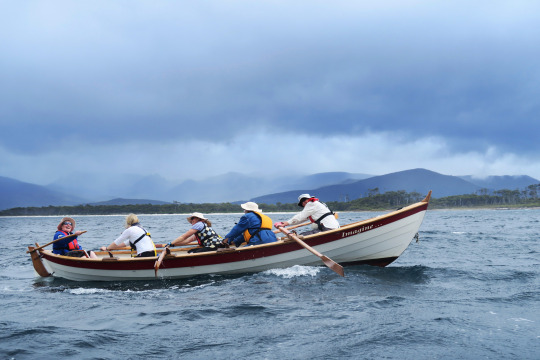
Further north we try to leave George The Third Rock to starboard. Somehow we manage to go dead bang over where it lurks sunken 6 ft below the surface. Blessed with a very shallow draft, the margin for us is comfortable. On a moonlit night in 1835 the 400 ton rigged sailing vessel the George III did much the same thing but with 200 convicts and 29 military guard on board. The results were tragic. In all, the ship carried 310 souls, two children having been born at sea.

She departed Woolwich on December the 14th 1834 under the command of Captain William Hall-Moxey. First, a careless fire almost got to the gun powder kegs in her magazine but for two convicts burning their hands crawling through the smoke to retrieve the hot copper powder kegs. 16 had died and 60 more were down with an outbreak of scurvy before she had reached the Tasmanian coast and foundered on this uncharted rock. A heavy ground swell set in, lifting and dropping the ship's bows heavily on the reef. It took about five thumps to stove her in. A strong guard with cutlasses and muskets were placed over the hatches but she began to fill rapidly and the mast collapsed. The guards fired their guns in order to quell rising panic. 133 lives were lost, including 128 convicts, many of them perishing in the hold.

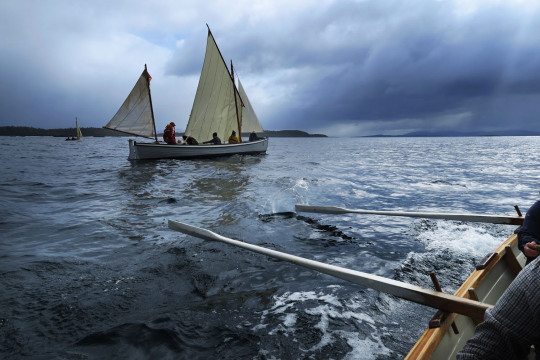
The wind has picked up considerably and the yachts are now roaring up behind, soon to over take us. We stop to take stock. When we turn the corner the wind will be directly on us and could be as high as 20 knots. The crew has bonded and is well prepared but our level of experience is very mixed. I have to be careful not to over commit. We have VHF radios and fleet safety boats so we are reassured.
A bottleneck has built up in the narrow between the shelter of Southport island and the point. Sailboats are now tearing past us: The Montagu, The Boxer, Theona and Hop the Wag all shoot by. One rowing skiff has rowed ahead and one lingers uncertainly behind us. I brief the crew over a quick lunch afloat. We are going to have a hard row against the weather aiming for the lee of Pelican Island.
The radio is buzzing with reports of capsizes and uncertainty about the conditions ahead, some of our fellow raiders, worryingly, are already in the water. I drift into a slight dream as we set off knowing I may have to distract and hold the crew happily to their task. Again I remember pirate Niall Odhar and that distant Outer Hebridean day around 1600 when the red pumping fear invoked by the sight of his Birlinn (longship) inspired the famous rowing song An t-Iorram Niseach. “My heart fears greatly that this is Niall Odhar in his Birlinn bearing down on us.” Sings Alan a’ Bhritheamh. He is rowing alone on one side of the boat while his two brothers both have an oar each on the other side, making the propulsion uneven. His mind is racing wildly everything is against him his world is tumbling apart in a flood of brine and straining sinew.
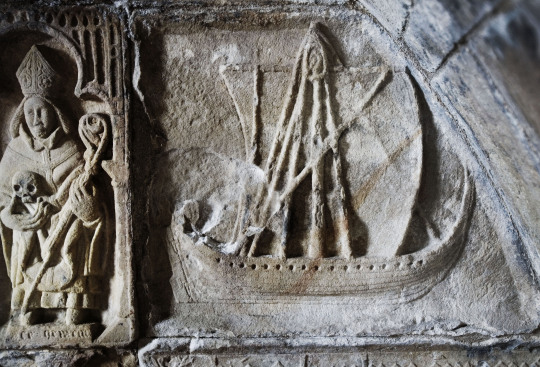
Now he is singing, first praising and flattering his fine brothers and boasting of his own strength. Quickly it is apparent that this eulogy is not enough. Second by second homicidal Niall continues to close the gap, with his two-tone Birlinn . Alan fixes on his brothers with his song and paints them a different picture: “I have a dagger in my hand, in the hollow above the fort, Niall Odhar is beneath me, I plunge the dagger deep into the creel of his chest and watch as the blood fills his gusset.” This is a premonition of what shortly follows for Alan and his brothers but unfortunately the key roles are reversed. Sung as a work song for the best part of 400 years these days you are more likely hear it on iTunes than at sea.
My attention returns to the crew. I remember vaguely that Jill has more sea experience than the rest of us and ask her to take the tiller. I take my turn at an oar and begin to sing quietly.
The team comes together and, fighting off fatigue they rest briefly in the shadow of Pelican Isle before finally beaching the John Liddy on the Southport shore with a new dignity and hard-won self respect. It is with embarrassment that I remember that I spoke rather sharply to Jill during a rather distracted moment, as I later learn…

With Jill Knight on the helm I was in better hands than Alan a’Bhritheamh could have hoped for. Although Jill is fairly new to this form of rowing, for thirty years she has travelled the world sailing single handedly on her 1894 built cutter, Cooee. Once, on the South China Sea, Jill, having received a radio call warning of pirates with only her cat Lucifer for company turned off the lights and sailed in darkness through the night to evade the buccaneers.
Jill recollects the earlier row to Southport. “I had no doubt that we could row all the way. After that day I understood why I suddenly love rowing. I have sailed for over 30 years but you feel more in control when rowing and less beholden to the whims of wind. Then there is the singing! “
“The 1894 New Zealand built cutter Cooee sailed into port and the owner, looking for crew, invited me aboard, offering to teach me navigation. I was totally hooked. We went to Asia, the Pacific, mainland China, which was unheard of back in 1985. Then I bought Cooee and went off on my own. I made every mistake there was to make and broke everything, one thing at a time normally! The learning curve went vertical. I went of to the Western Philippines, Borneo and muddled along with my strong-hulled boat. She looked after me for all those years. Then to Singapore, Sri Lanka and across the Indian Ocean via the Chagos Archipelago. That crossing, from Sri Lanka to Mauritius, involved more than five months without reprovisioning. Stowing a lot of rice, on the islands there was unlimited seafood and lots of coconut crabs, huge land crabs that can be a metre from claw to claw. You just eat the legs."
Her career as a writer took off with magazine articles and books. Describing the adventures of one woman sailing oceans with her cat Fletcher, shipmates for 20 years. Sadly the cat Lucifer who fled the pirates with her was short lived.

Saturday 4th February. Southport to Dover. Wind WNW 18 Knots. Distance: 12 Nautical Miles
I have prepared meticulously for this voyage buying the cheapest fishing hand line on sale at Franklin Marine and a large bag of giant liquorice allsorts. Today this forethought pays off and I land a decent sized squid near Faith, Hope and Charity Islands. This frisky squid is in luck with this soft centered entirely female crew: Christine , Linda, Penny and Sarah, either it is his long legged charm that persuades them to make me let him go or perhaps they are afraid of getting inked. He makes his body bulbous and puckers up as I release him from the hook!

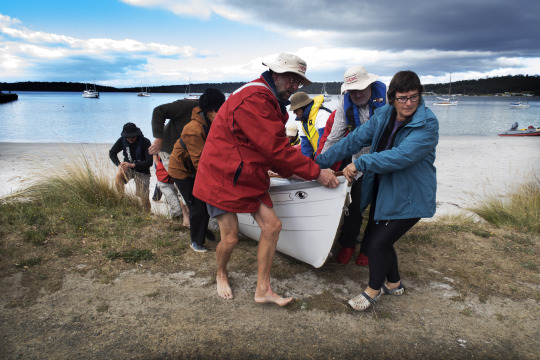
Sunday 5th February. Dover to Randalls Bay. Distance: 10 Nautical Miles. Wind: N morning 10-15 knots and SW in the afternoon 15-20 knots.
Things start badly. A mob of raiders has gathered to helpfully carry the skiffs down the beach from above the high tide mark and turn them round to point bow to sea. As my boat, the John Liddy, becomes a multi-legged insect like creature and springs lightly up from the sand, I see disaster unfold. They are turning her anticlockwise. “Clockwise, clockwise!” I cry but to no avail. They have impishly gone purposefully anticlockwise. I can see Allan Macleod glowering at me on golden sand of Bostadh beach, way back in the Hebrides, as he told me “Always sunwise. Always!” In my native Gaelic this in principle is named as deiseal. This is ” the prosperous course, turning from East to West in the direction taken by the sun”. As was observed by Druids states Edward Dwelly in his dictionary.
I am crestfallen. There is some teasing about sunwise in the southern hemisphere being anticlockwise and that perhaps Satan hasn’t really been summoned?


The water is glassy and the wind slight as we round Esperance point. It ripples and chinkles around the slender shoulders of the bow as you might sweep your hand through a delicate chandelier. The sun is burning strong and helmsman Will Hallinan narrows his eyes under the shadow of his wide brimmed leather hat. I can almost hear strains of Ennio Morricone music. Todays weather forecast certainly has elements of the good, the bad and the ugly – first calm; then scorching sunlight; to be followed by a strong wind on the beam later. As we approach our lunch stop at Surveyors Bay, our ten dollar fishing line goes tight and we bring on board a tasty looking Australian salmon.
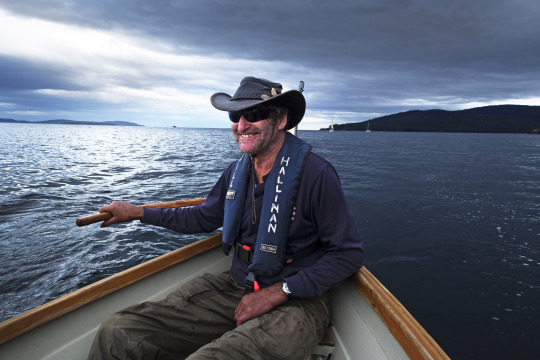
Rower Will Hallinan grew up in Kerang in North Victoria. Meaning ‘moonlight over water’ in the Aboriginal language, it was once an inland sea, he explains. To Will it is “The Land of the Lost Contour Line”.
“There is only one contour line and it keeps moving around because it is so flat. One night I was out chasing rabbits in the dark. I used to run rabbits down cos I didn’t have a gun. A rabbit can run fast but it cannot run far, only about a mile and a half, and I’d pop it on the head with a mattock handle.”
“I came from a big family - six brother and six sisters.” His mother died giving birth to the eleventh child. “Dad pretty well fell apart, he couldn’t manage the farm and the kids. He did as well as he could but he couldn’t manage without mum.” Will spent time in an orphanage as his father tried to cope with running the farm and looking after the children. “Eventually dad remarried and got us all back home again. It was never the same.”
“I work for the National Parks track working. I do things like maintenance and cleaning. Forest fires I do not enjoy at all. Canopy fires when they are huge, are like a jet roaring so loud that you cannot hear yourself think, and so tremendous is the heat you have to clear off or you’ll get cooked. I do enjoy peat fires deep in the ground. The peat gets so dry it just continues to burn underground and you’ve actually got to search for it with your hands. Often I take my gloves of and find the heat that way and dig it up or dowse it. You ‘ve got to be really persistent or they’ll just pop back up again.”
“I must say on that trip from Surveyors to Randall’s Bay when the wind was coming beam on and I was on the weatherside, it was really hard to time the waves and catch them or not get caught yourself. It felt immensely wonderful to come through it. Rowing is my form of meditation.”

Terra Nullius is a latin phrase deriving from Roman Law meaning empty land. As recently as 1598 there was an unexpected outbreak of Terra Nullius in the Outer Hebrides. Shortly before unifying the crowns and expanding his horizons King James the VI of Scotland had tired of what he later described as “sic a unfamous byke of lawless lymmaris” that is: “such a wasps nest of thieving vagabonds”. He was referring to the population of the Outer Hebrides. His solution was to grant a charter to a syndicate of loyal sycophants to take possession of the island of Lewis from the invisible indwellers and establish a new colony. As historian W. C. MacKenzie puts it in his History of the Outer Hebrides in 1903: “This Syndicate of chartered buccaneers was brought into being, with aims which the most hardened association of money-grubbers of the twentieth century might hesitate openly to avow. By their King, they were directly incited to accomplish the process of "civilisation," much in the same manner as the early settlers in Australia "civilized " the aboriginal blackfellows.”
Unfortunately pirate Niall Odhar was not a subscriber to the doctrine and the invaders were repelled after only a few months. It distracted Niall badly from his true calling; the devastation of his own clan and extended family by internecine strife and murder.
Despite having taken up new lodgings in the far south, King James (by now known as The First of England) played his role in advancing a second invasion. It was executed in 1607 with a new directive for settlement by the new colonists "not by agreement with the countrey people, bot by extirpatioun of thame".
So called ‘justice’ finally caught up with Niall in 1613 when he was hung in Edinburgh at the Mercat Cross with his severed head displayed at the Netherbow Port.
Terra Nullius in Tasmania was much more devastating for the Aborigines. They were denied recognition as British Subjects and were defined as people who live “in a savage state”. In 1800 “Richard Atkins, the Judge Advocate in Sydney, ruled that it was impossible to bring an Aborigine to trial for a crime committed against either a colonist or another Aborigine…. At the same time it was becoming impossible for any colonist to be arrested and charged with the murder of an Aborigine.”
Lyndall Ryan writes in her book Tasmanian Aborigines.
There is no meaningful comparison between the two geographical experiences, only irony in observing the way in which the Scottish and British crowns expanded their ambitions after such modest beginnings with homegrown schemes and in how the victims of the earlier domestic plantations went on to become the settlers, who went out into the new world and brought catastrophe on a variety of indigenous peoples.

Monday 6th February. Randall’s Bay to Simpsons Bay. Distance: 12 Nautical Miles.
Clearly Satan was summoned yesterday by the bad, centipede-like John Liddy pirouetting anticlockwise. I have woken in my tent to find that my face is a potato. A bright baked lumpy one. My eyes will barely open. I look like a bust badly modeled out of old plasticine by a distracted child. I join my fellow campers and put half of them off their breakfasts. There are sympathetic remarks as to whether it is bad sunburn or an allergy. Kindly camp pharmacist, Rob Blackburn runs away to find some lotion, but I know what is. It is ‘breitheanas’. The sea god, Seonaidh, has been angered and this is retribution. Martin Martin describes how easily this can happen in his circa 1702 guide to the Western Isles of Scotland. Seonaidh can be pacified by an offering of beer but, looking at myself in my mobile phone, I know it’s far too late for any pale ale remedy
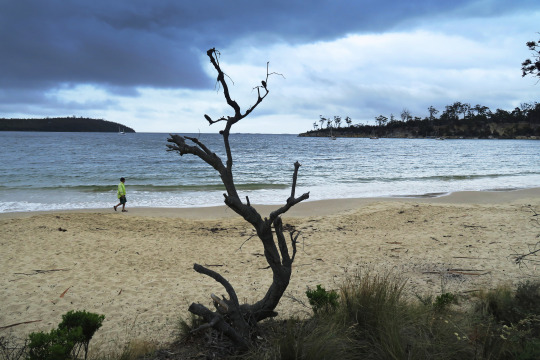
Tuesday 7th Febrary. Wind: E 15-20 Knots ESE later. Simpsons to Quarantine bay on Bruny Island. Distance: 10 Nautical Miles.
My face has flaked off. I have no further use for sun cream. Instead I need a facial version of Head and Shoulders. Making our way north from Simpson’s Point we spend a time watching a family of White Bellied Sea Eagles sun their proud stomachs at Robert’s Point. They are not true eagles as they do not have feathered legs but are in fact giant kites with a taste for fish.


Wednesday 8th February.
Wind: in excess of 30 knots.
Bad weather has us all land lubbered on Bruny Island for the day. We have been promised a special treat for lunch back at the camp to compensate for the unpleasant wind blowing out at sea. A deluded rumour spreads that it’s to be oysters so we fill in time by cajoling fellow sailor and rower Endra O’May into taking us on a tour of the nearby Aboriginal flint quarry at Quarantine Bay.
“The Aboriginal people go back 40 to 60 thousand years in Tasmania. For many hundreds of years the aborigines from around would have come here to make their flints because the stone is so good. They hit the stone and shards fall off the core stone. They lived here as well. You always get a midden on a point like this with fresh water and a lovely view. Every time they lit a fire and had a meal the leftovers were left right here”, explains Endra.


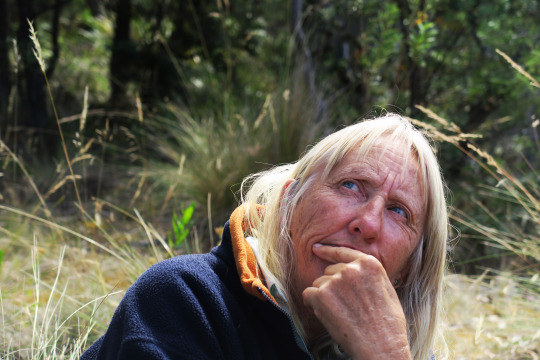
“I started to row when I was about two. You rowed and sailed like other kids have bikes. It was very natural to grab a boat and a fishing line and off you would go. When you live on the land, doesn’t matter where in the world, the land moves through your body, you start to get the wisdom of the land, you get instinctive and intuitive about the land which is how the Aboriginals lived. When the white people first arrived they found the bodies of aboriginals placed carefully in the trees, like a burial tree. Truganini’s birth tree is a fair way inland from here. “
Born in 1812, Truganini became the most famous Tasmanian Aborigine woman. Many claiming at the time that she was the last full blooded Tasmanian Aborigine. Her father was Mangerner Chief of the Lyluequonny clan of the South East nation from Recherche Bay. By 1829 aged 17 she was living with her father at Rat Bay on Bruny Island, her mother had been killed, stabbed by sealers, her sister Moorinna had been accidentally shot after being abducted, her fiancé Paraweena was killed by sawyers who threw him out of a boat then cutting off his fingers as he tried to cling onto the side.
She saved George Augustus Robinson, the dubious Protector of Aboriginals from falling into the hands of the Tarkiner clan at the Arthur River by ferrying him across on an improvised raft using his garters and cravat to fasten the timbers. In 1841 she was in the company of two young warriors, Maulboyheenner and Pevay, who shot two whalers named Cook and Yankee. Maulboyheenner and Pevay hung for the crime but Truganini returned to the so-called Protectorate at Wybalenna on Flinders Island.
The Protectorate was moved to Oyster Cove, where there was a flint quarry that had been used by her late father and late husband. She visited her former home, Bruny Island, and got the opportunity to pass on skills and traditions to children. These included how to sing corroborree songs and how to read the stars. Her great fear was that on her death she would be mercilessly dissected, treated as a scientific curiosity, as befell her friend William Lanney in such gruesome fashion and that she would be subsequently displayed callously in a museum. She clearly stated her wishes that she be buried “in the deepest part of the D’Entrecasteaux Channel”.
She died in Hobart aged 64 in May 1876 with her beloved dogs around her. Despite the attempts of the Royal Society of Tasmania to obtain her corpse as “a valuable scientific specimen”, Truganini was given a decent burial at the old Female Factory at Cascades with her friends and family present. She was only accorded this human decency for two years after which, in contradiction to her and her supporters wishes, her bones were exhumed by The Royal Society of Tasmania, put in a box, before being articulated into a skeleton and put on public display at The Museum of Tasmania where this obscenity continued until 1951.
It was not until 1976 that her descendants succeeded in securing the return of her remains - allowing her cremation and the final granting of her wishes when her ashes were scattered according to her wishes, only a hundred years late.
The surprise lunch turns out to be a taco van arriving on the seaward edge of our tented village. The tacos are delicious.
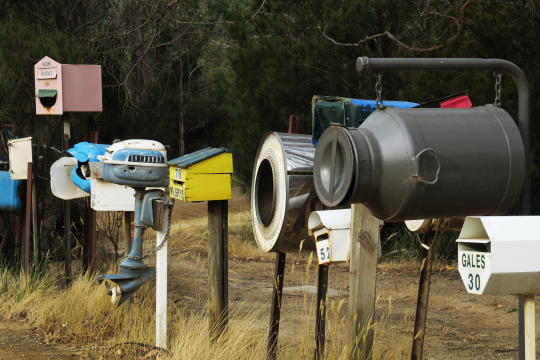

Van Diemen's Land, as Tasmania was then known, was created in 1803 as a British penal settlement. 75,000 convicts were sent to Van Diemen's Land before transportation ceased in 1853.
We are on the second leg of the Tawe Nunnuggh and at the helm right now is Jodie Ebinger. No stranger to convicts, Jodie is a policewoman. “Dealing with offenders is like dealing with the water. My policy is to respect them,” she tells us.
Jodie grew up in Wangeratta in northeast Victoria. After moving to Melbourne to study, she worked for ten years in the social work disability field before becoming disillusioned with the continuing funding crisis. "I was doing some soul searching and ended up joining the police force. I’ve been in the police force for eleven years now."
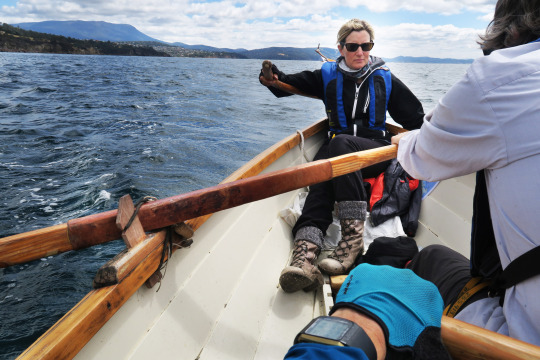
Five years ago her son Jesse was born with Down’s Syndrome. "I decided to take time off work, knowing that the long term outcomes are far better if there is quite dynamic early intervention. So, I‘ve been doing that but it’s very very exhausting. He’s always on the move. So, one day I saw an advertisement in the newspaper for this boat building in Williamstown and I’d just been speaking to another mum, in the same boat as me and we both love the water. It ticked the box! My friend and I had discussed that we need to do things for ourselves. I want my world to be bigger than just about my son. So I turned up for an information session, went for a row, loved it, met like-minded people and just instantly felt at home. It’s been great."
"With this rowing raid, I had reservations but I decided I’ll throw myself in the deep end. “Policing is very “interrupt driven” you gotta think on your feet, deal with whatever is thrown at you, the weather can change really quickly, it can get to the point of life threatening.
"One example stands out - a nasty domestic incident involving this guy, Maraffko. He had falsely imprisoned, bound and gagged his partner. Along with my female partner, I arrested and interviewed him. I remember at the end we had to get him accommodation as we often have to. He looked at me and said “You care." which left me feeling uncomfortable, but as I say, I was respectful and just did the job."
"Some weeks later I was on duty and a report came on the radio of a guy that had 'gone off' and had to be arrested right in the Main Street in the middle of the day. When the familiar name “Maraffko” came over the radio I knew what we were dealing with. They were calling for backup I began to fear that this might be a case of attempted suicide by police. By the time I we got there he had walked into a side street and the available units were trying to arrest him. Because I'd dealt with him before I called out to him and started to engage him. I felt safe enough to get closer bit by bit, enough to talk him down so that he could be peacefully arrested. Much later on I was listening to the news. Maraffko had been arrested for murder. It was an awful scenario. A young mother killed in front of her kids. He'd used the same modus operandi that he had with our victim."
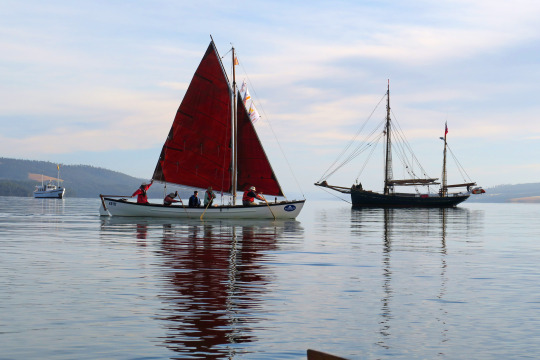
“ You have to respect the person to get a better outcome, I see clearly it's the same on the water. Let the exciting or perhaps the dangerous times be the ones you can't avoid not the ones you create out of stupidity. And hey, your crew are more likely to want to hug you at the end."
Thursday 9th February. Quarantine to Mary Ann Bay at South Arm.
Wind: SSW 15-20 Knots later S. Distance: 13 Nautical Miles
As we depart Barnes Bay, a pod of dolphins accompanies us, almost translucent, swimming just beneath and beyond the oar tips. Coming up to South Arm an angry wind chop rises from the south. It laughs at us and at the forecast, exceeding 20 knots and erratically backing easterly. We are in the wrong place at the wrong time. The sea gradually takes away the crew's respect and affection for each other, tears it to pieces and throws it at our feet. The safety boat Stella Irene stands by unable to intervene but ready to pluck us out of the water if and when we go down.

The responsibility hangs heavily around my neck. Consensus and communication disintegrates. The situation is a sobering one. We have to overcome our difficulties and quickly get our wits about us. Grimly, we focus on staying afloat. The following sea is ragged, shape-shifting waves are breaking into the boat. We abandon our course and run before it. I am on the tiller the destination is now undefined. Anywhere but here. It appears to ease a little. Calling for hard on starboard we take a big one. Now we are all soaked and fatigue is kicking in. Salt water sloshes around our feet. It does finally ease and we get to our intended destination. We pull the John Liddy up the beach barely speaking to each other.
While I am shabbily setting about pitching my tent a lightly bearded man approaches me. He is our safety support from the Stella Irene. He states the obvious: "You had it rough out there."
“Yup” I say, tossing a bent tent peg aside. He offers to chair a debrief. I shrug and screw up my face, he keeps talking and I concede that it is the best option.
A small sea of unhappiness envelops us as we work our way through it all again but under Rob's leadership that is what we do - we negotiate it together once again. There is nothing easy or pleasant about it. I feel like shit. The talk peters out and Rob steers us to a conclusion.
I have a few drinks and stay back from the camp laughter and chat. Before I head back to my tent I finally work up the courage to sneak a look at tomorrow’s sign up sheet for my boat, the John Liddy, fearing he will need to be re-gendered as the Marie Celeste. Illuminating the scrawled names with my phone, I feel a swell of emotion and my eyes brim. There they are, back again, my shipmates, willing to give me another chance and to share our triumphant last day as we join a fleet of boats to parade into Hobart on the first day of the Australian Wooden Boat Festival.
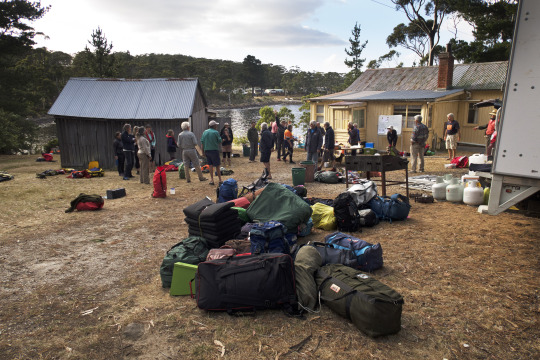
Lyndall Ryan describes a sight near present day Hobart in her book Tasmanian Aborigines:
On a cool spring day at the end of the first week in September 1803, a family of the Moomairremener clan for the Oyster Bay nation on the eastern shore of the River Derwent saw a large white bird near the rivulet at Risdon Cove. The next day they saw another draw up alongside. They had seen such birds before and believed the human strangers they carried were Wrageowrappers, devil men’s spirits…for the first time, some white devil women and children had come to stay.

Please allow us to introduce ourselves, modern Wrageowrappers in our little Scottish inspired plywood clinker built birds with our oars beating gently as we glide towards this town named after Lord Hobart, the Secretary of State for War and the Colonies until 1804 - no doubt a man of wealth and taste. We are followed by a wave of tall ships, yachts and all sorts of elegant traditional wooden vessels running on their attendant cloud of sails. What could be grander than the three masted James Craig, launched in Sunderland in 1874; the topsail schooner Enterprize and the towering Tenacious of ancient appearance but equipped with 6 wheel chair lifts - even one for ascending the mast. We all share a deep feeling of satisfaction and a sense of arrival but for me it does nt derive from the destination nor from today’s pageantry. It comes from the journey shared in these able little St Ayles boats, from friendly faces and the chequered feint ghosts of legend. I am today as grey as the Lewisian Gneiss ridges that framed my childhood, age is eroding me but these journeys are carving an intricate inner coastline that I will visit and revisit for years to come. That’s my game.
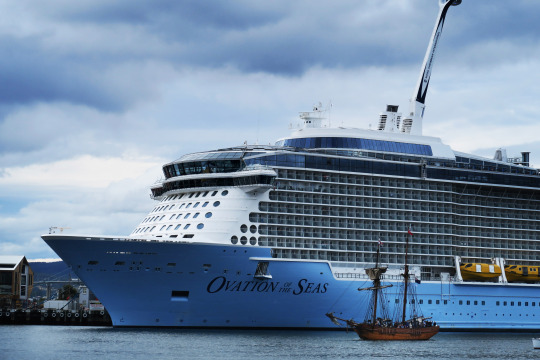

A salt-encrusted raid mob trudges to Hobart’s Hope and Anchor Tavern, opened in 1807 and with rifles and cutlasses still hanging on the walls. “Civilisation is only 3 beers deep,” advises Kiwi rower Don Currie and after a few jars a woman at the bar is cheerfully jostled and encouraged forwards by a tired and elated crowd. Caledonian skiff skipper Ali Grant steps forth and leads everyone into song “C’mon and roll...” starting a riotous improvised version of the ancient sea shanty “Roll the Old Chariots.” Rum bottles shake on the shelves. For as this version states “A damned good wash wouldn’t do us any harm.”

Special thanks to Lyndall Ryan for permission to quote from her book Tasmanian Aborigines ISBN 9781742370682

#shawbost#rowing#an eathar#skiff#st ayles#scottish#coastal#tasmania#Tawe Nunnuggh 2017#tawe#Tawe Nunnu#Nunnuggh#niall odhar#siabost#nunnagah#nunnugah
1 note
·
View note
Photo

Lunawanna Allonah (Bruny Island, Tasmania)
2016
This image was taken at the popular tourist site called the neck on modern day Lunawanna Allonah (Bruny Island), where the seperate Islands of South Bruny and North Bruny are joined by an incredibly picturesque spit of land. D’Entrecasteaux Channel is just out of frame separating the islands from the mainland. It was here that Truganini the last surviving Palawan (Tasmanian Aboriginal) requested for her ashes to be scattered after death.
© Dylan Smyth Instagram Website Store
The Horrific Story of Truganini, last surviving Palawan (Tasmanian Aboriginal).
Born on Lunawanna Allonahin around 1812 Truganini was of the Nuenonne. Coming of age at the time of the Black War in Tasmania by the age of seventeen Truganini had seen no less then her Uncle shot by a soldier, her sister abducted by sealers, her mother killed by soldiers and her fiancé brutally murdered by wood-cutters who sexually abused her. Detained for most of her life Truganini was held first in a mission on Lunawanna Allonah before being shipped to a Flinders Island settlement called Wybalenna (black mans houses). Moved to Oyster cove near Hobart Truganini became the sole survivor of that settlement and was finally moved to Hobart where she died three years later. Mothering a child during a brief stint of freedom in Victoria Truganini hid her daughter from the authorities, was hunted down and once again detained and sent back to Tasmania without her daughter.
Anticipating that she would be mistreated after her death Truganini pleaded to have her ashes scattered in the D’Entrecasteaux Channel. This request was ignored and two years after being buried Truganini was exhumed and put on public display by the Hobart Museum.
0 notes